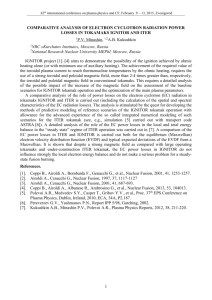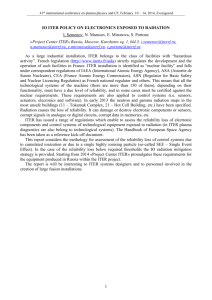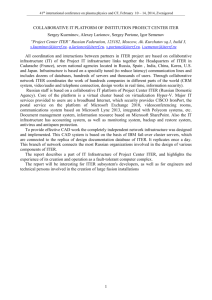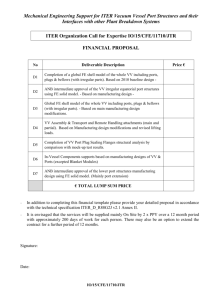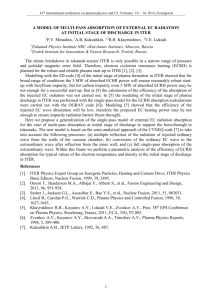3.3.3.3
advertisement
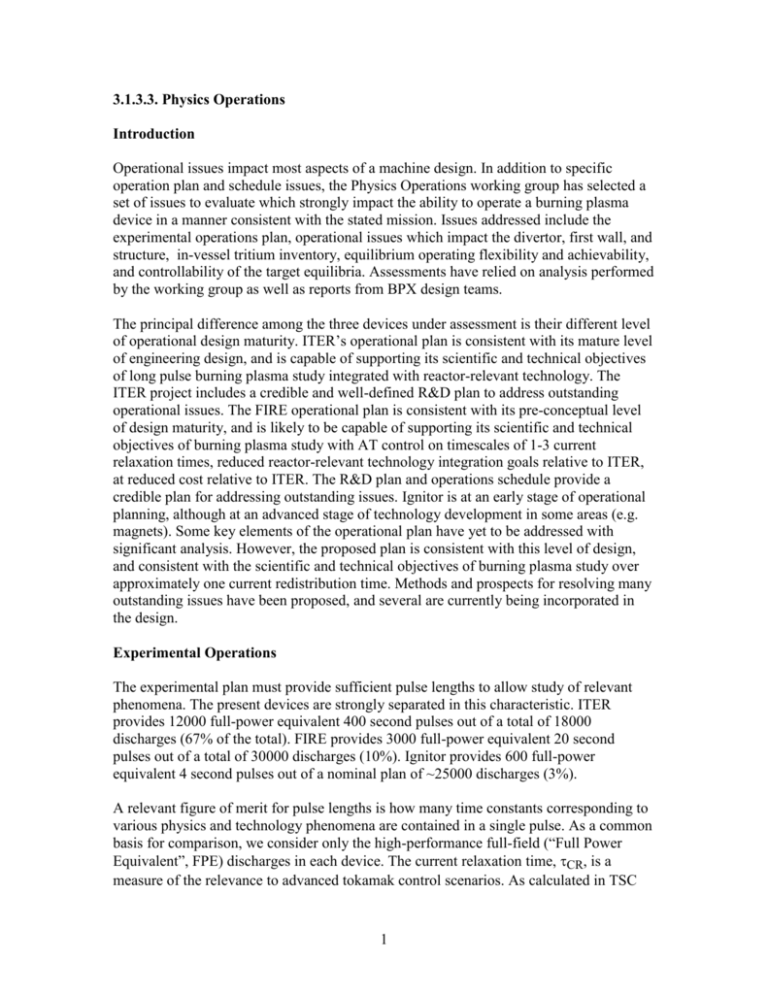
3.1.3.3. Physics Operations Introduction Operational issues impact most aspects of a machine design. In addition to specific operation plan and schedule issues, the Physics Operations working group has selected a set of issues to evaluate which strongly impact the ability to operate a burning plasma device in a manner consistent with the stated mission. Issues addressed include the experimental operations plan, operational issues which impact the divertor, first wall, and structure, in-vessel tritium inventory, equilibrium operating flexibility and achievability, and controllability of the target equilibria. Assessments have relied on analysis performed by the working group as well as reports from BPX design teams. The principal difference among the three devices under assessment is their different level of operational design maturity. ITER’s operational plan is consistent with its mature level of engineering design, and is capable of supporting its scientific and technical objectives of long pulse burning plasma study integrated with reactor-relevant technology. The ITER project includes a credible and well-defined R&D plan to address outstanding operational issues. The FIRE operational plan is consistent with its pre-conceptual level of design maturity, and is likely to be capable of supporting its scientific and technical objectives of burning plasma study with AT control on timescales of 1-3 current relaxation times, reduced reactor-relevant technology integration goals relative to ITER, at reduced cost relative to ITER. The R&D plan and operations schedule provide a credible plan for addressing outstanding issues. Ignitor is at an early stage of operational planning, although at an advanced stage of technology development in some areas (e.g. magnets). Some key elements of the operational plan have yet to be addressed with significant analysis. However, the proposed plan is consistent with this level of design, and consistent with the scientific and technical objectives of burning plasma study over approximately one current redistribution time. Methods and prospects for resolving many outstanding issues have been proposed, and several are currently being incorporated in the design. Experimental Operations The experimental plan must provide sufficient pulse lengths to allow study of relevant phenomena. The present devices are strongly separated in this characteristic. ITER provides 12000 full-power equivalent 400 second pulses out of a total of 18000 discharges (67% of the total). FIRE provides 3000 full-power equivalent 20 second pulses out of a total of 30000 discharges (10%). Ignitor provides 600 full-power equivalent 4 second pulses out of a nominal plan of ~25000 discharges (3%). A relevant figure of merit for pulse lengths is how many time constants corresponding to various physics and technology phenomena are contained in a single pulse. As a common basis for comparison, we consider only the high-performance full-field (“Full Power Equivalent”, FPE) discharges in each device. The current relaxation time, CR, is a measure of the relevance to advanced tokamak control scenarios. As calculated in TSC 1 simulations, Ignitor provides 0.92CR in a single pulse of 4-second burn time, FIRE provides 2.0CR in its 20-second pulse, and ITER provides 2.6CR in its 400-second pulse. The same analysis applied to energy confinement times provides a measure of confinement physics productivity potential. Ignitor, FIRE, and ITER pulses contain ~7, ~20, and ~120 E respectively. Divertor/First Wall and Structure Operational Impacts Heat loads on divertors and first walls pose a particular challenge to all BPX devices, with typical steady state divertor fluxes (in the absence of radiative mitigation) in the range of 5-15 MW/m2 and disruption thermal loads of 30-100 MJ/m2 in less than a few milliseconds. Type I ELMs in particular are a divertor lifetime-limiting issue in both FIRE and ITER, whose baseline operating regime is presently the ELMy H-mode. Both devices are expected to produce similar heat loads to their divertors in the range of 1-5 MJ/m2/ELM. A single type I ELM will produce a melted layer in the W divertor plate in both FIRE and ITER (if a W divertor is installed in the later phases of operation), of approximately 10-100 m. The operations consequences of limited melting of plasma facing surfaces are not well-understood, but available machine experience indicates that operating with previously melted surfaces can degrade plasma purity, increase disruptivity, and increase the fraction of discharges that fail to reach performance goals. Assuming complete loss of the melt layer, the divertor lifetime is limited to approximately 100 discharges in each device (similar for tungsten or carbon divertors). Solutions to this severely limiting divertor erosion include developing target equilibria which produce type II instead of type I ELMs, operating in a stationary ELM-free mode (e.g. EDA, QH), or mitigating ELM effects with impurity injection. The baseline hightriangularity, DN configuration of FIRE is favorable for achieving type II ELMing regimes. Ignitor envisions a near-DN operating scenario which could produce ELMs, but the details of this scenario are presently not sufficiently well-defined to allow assessment of the wall impact. Disruption heat loads produce a similar lifetime limitation in the BPX devices. ITER and FIRE experience comparable divertor heat loads of 1000-4000 MJ/m2/s1/2 in unmitigated full-performance disruptions, which produces a tungsten melt layer of ~100 m in each device (for the ITER W divertor option). A similar thickness of carbon is ablated from the ITER C divertor, which is planned in the early phases of operation. A molybdenum melt layer of ~100 m is likely produced on the first wall in each Ignitor disruption. In each device the lifetime of the divertors (FIRE, ITER) and first wall (Ignitor) is approximately 100 disruptions (~1000 discharges assuming 10% disruptivity) before replacement is necessary. Injection of large quantities of noble gas produces a preemptive radiative collapse which distributes the thermal and magnetic energy isotropically to the first wall. Typically less than 1-2% of the energy is conducted to the divertor in this process. Calculations show that following injection of neon the ITER and FIRE first walls would experience thermal loads of 15-20 MJ/m2/s1/2, below but near the melt limit of the Be first wall material they share (~20-25 MJ/m2/s1/2). Employing this method of mitigation in Ignitor serves to increase the area over which the energy (> 43 MJ/m2/s1/2) is deposited relative to the unmitigated case, but still somewhat exceeds the 2 melt limit of Mo (~40 MJ/m2/s1/2). The resulting melt layer thickness is estimated to be 10-100 m. The wall lifetime, even if all disruptions are mitigated, is therefore similar to the unmitigated lifetime of ITER and FIRE divertors and the Ignitor first wall (1000 discharges, assuming complete erosion loss of the facing material and a disruption rate of 10%). An important and often dominant source of local electromagnetic (EM) stress in tokamaks is the poloidal halo current which is driven during disruptions when the plasma becomes limited. Calculations of halo currents driven during VDE’s show that Ignitor, with the largest vertical growth rate (~80 rad/sec) and toroidal field (13 T) among the three devices, produces the largest pressure on the vessel (> 6 Mpa) during a VDE of all the BPX designs. This pressure produces several cm of displacement of the 2.6 cm-thick Ignitor vacuum vessel during the dynamic evolution of the disruption, and exceeds the plastic yield limit. Ignitor is presently undergoing a redesign of vessel support structures in order to withstand these forces, but in-vessel misalignment of PFC’s is still a concern. While the EM loads in FIRE VDE scenarios are below allowables (calculated to be ~4 Mpa in the nominal VDE scenario), the addition of neutron heating-induced thermal stresses in the vessel to the disruption EM loads produces a total stress near cyclic allowables in the present design. Redesign of the vessel, support structure, FW tiles, and structure heaters is underway to reduce the total stress. ITER loads are well within allowables in all disruption scenarios (calculated to be ~0.5 Mpa in the nominal VDE scenario). Impurity injection mitigation would reduce the halo pressure in all devices. Calculations show that at least 50% of the plasma current is likely to be converted to runaway current carried by high-energy (typically ~10 MeV) electrons in disruption current quenches. The limiting level of damage to plasma facing components (PFC) before replacement or repair is necessary is difficult to assess, but given the total energy of the runaway channel (~240 MJ in ITER for IRE~0.5IP), it is likely to be essential that runaways be suppressed in all three BPX’s. Gas mitigation has been demonstrated to suppress runaway production completely with sufficient injected density, and analysis of BPX scenarios shows that a relatively modest amount of impurity (producing a neutral density ~1022 m-3, 10-3 bar) at easily achievable gas jet pressures (~2-10 bar, limits corresponding to ITER and Ignitor, respectively) will provide this complete suppression. RE suppression specifies a maximum allowable current quench time. However, disruption thermal load mitigation by gas injection requires a sufficiently long current quench time in order to produce a sufficiently low radiated power. In FIRE and ITER there exists a common scenario for simultaneous mitigation of RE and reduction of thermal loads below the Be melt limit. Because of its uniquely large magnetic energy, the majority of the energy in a mitigated Ignitor disruption is released during the current quench. Simulations of Ignitor disruption mitigation suggest that there is no single current quench time (and therefore no single-species injection scenario) which allows simultaneous RE suppression and reduction of wall thermal loads to below the Mo melt limit. Multi-species gas mitigation offers an opportunity to satisfy both timescales, but is still an early, unproven concept. For all BPX’s, disruption mitigation presumes a disruption prediction/detection system that is sufficiently fast and reliable. Because such 3 systems presently exist only in rudimentary form, insufficient for a BPX, significant development will be required to satisfy this need. The ITER baseline plan includes operation with carbon divertor plates in the initial phases of operation (including initial DT operation). Modeling and simple extrapolation from experimental data suggest that a 1.5% retention rate is likely in the ITER C divertor. The ITER fueling level of 250 g of T results in ~3.8 g per discharge, or ~100 shots before reaching the ITER in-vessel limit of 350 g-T, requiring shutdown and in situ cleaning or replacement of the divertor. The ITER baseline plan includes replacement of the C targets with W before entering full power DT operations, while R&D efforts plan to alleviate T retention by use of such methods as dedicated C/T cold traps. The FIRE baseline divertor design includes W targets during the entire life of the machine, with T retention below 1% allowing more than 5000 discharges before replacement. Ignitor’s Mo first wall baseline design allows execution of its full operational plan without requiring replacement due to tritium loading. Equilibrium Operational Issues The shaping flexibility and scenarios of ITER are adequate for its stated mission. Extensive design and analysis has demonstrated that the power supplies and PF coil capabilities can achieve the range of shapes required with reasonable variation in profile parameters. All planned scenarios are controllable with demonstrated dynamic performance consistent with both physics and machine operational requirements. NearDN equilibria can be achieved in the reference scenario (~1.85, ~0.55). Long pulse AT capability is provided, with demonstrated capability to achieve >2.1, >0.6 with pedestal parameters consistent with DIII-D AT scenarios. FIRE has chosen strong DN shaping parameters for nominal values, consistent with and adequate for its mission. Satisfactory shape control performance has been demonstrated consistent with the preconceptual level of the FIRE design in TSC simulations. The elongation can be varied very little about 2.0 at the X-point, 0.05 at full minor radius. Triangularity can be varied from 0.6 to 0.8 at full minor radius. Vertical stability analysis and some degree of dynamic shape control analysis has been done. Nominal achievement of Ignitor limited and near-DN equilibria within power supply and PF coil constraints has been demonstrated. However, only limited dynamic control studies have been done. Vertical stability control has been assessed in the limiter configuration and found to be consistent with power supply and PF coil constraints. Detailed dynamic control characteristics and requirements of the near-DN configuration are expected to be demanding and deserve careful analysis. In the absence of strong pumping, the rapid ~3.5 MA/s rampdown in the standard Ignitor scenario is likely to produce an extremely high internal inductance and a density limit disruption. Pre-emptive gas mitigation just prior to the disruption may provide a solution, since much of the magnetic energy will have been dissipated by that time. The baseline rampup scenario for Ignitor requires very large voltages and ramp rates compared with present machines. Consistency with achieving stable, monotonic target equilibrium current profiles at 11 keV by the end of rampup has yet to be demonstrated. 4
